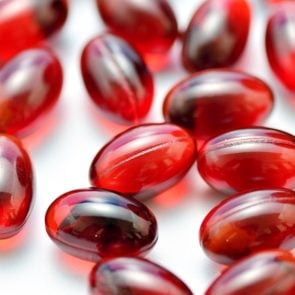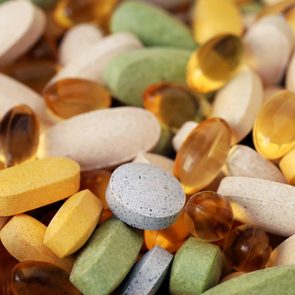Everything You Need to Know About Supplements for Joint Pain
Updated: Mar. 30, 2022
Supplements are widely used to manage joint pain, but the science on their effectiveness is limited. Here's what to know about common supplements before you try.
Our editors and experts handpick every product we feature. We may earn a commission from your purchases.
Using supplements for joint pain
When you’re dealing with debilitating chronic pain from joint problems, any potential solution—especially when it’s as easy as taking a pill—would be a welcome relief. The Centers for Disease Control and Prevention (CDC) says that one in four U.S. adults—or 15 million people—experience severe joint pain from some form of arthritis, a common cause of the symptom.
While there are other recommended natural arthritis remedies that work for joint pain, such as exercise, physical therapy, and psychological therapies, the use of over-the-counter supplements of natural and chemical compounds has been gaining in popularity.
What causes joint pain?
With joint pain, “there can be damage to the joints, muscles, bones, and tendons, either mechanically, via degeneration, or by inflammation,” says Nilanjana Bose, MD, a rheumatologist at Memorial Hermann in Houston. “This stimulates the nerve ends to sense pain.”
Taken together, these joint conditions are called arthritis. “Arthritis may be due to damage, such as an old injury, or inflammation, such as that caused by rheumatoid arthritis,” says arthritis specialist Scott Zashin, MD, a Dallas-based rheumatologist and author of Natural Arthritis Treatment. “When there is damage or inflammation, chemicals are released that communicate with the nervous system, causing pain. In addition, the release of inflammatory substances also plays a role in the stiffness many patients feel with arthritis.”
Osteoarthritis is a result of the wear and tear that happens to our joints as we age. It’s the most common type of arthritis, affecting one in seven U.S. adults.
Inflammatory conditions that affect the joints include gout and autoimmune disorders such as rheumatoid arthritis, psoriatic arthritis, and lupus, which cause the body to attack its own tissues, specifically in the joints.
The pain condition fibromyalgia can also cause joint discomfort.
The hope is that supplements may act on the causes of joint pain to provide relief. “Vitamins and supplements, if they help, may do so by decreasing inflammation as an anti-inflammatory and/or decreasing pain as an ‘analgesic,'” Dr. Zashin says.
(Here’s what to do if want healthy joints and cartilages.)
What the science says about supplements for joint pain
The evidence is far from conclusive that these supplements help. One 2018 review of research, published in the British Journal of Sports Medicine, found that some supplements provided only short-term relief. Importantly, the researchers note that the quality of evidence of the studies was very low and many studies were funded by companies that produce supplements.
Most supplements may only have minor side effects, but it’s important to know they haven’t been rigorously tested the way other approved drugs have been.
“Because vitamins and supplements have not undergone rigorous study, as found in a Food and Drug Administration (FDA)-approved treatment, patients should always consult their medical professional if they are interested in trying one of these over-the-counter remedies,” says Dr. Zashin.
The thing that’s bound to be hurt most, though, is your wallet: These supplements aren’t cheap. Still, if you can afford supplements and get your doctor’s OK, you may want to give these a try if other joint pain remedies aren’t working for you. (Here are some other options for protecting your joints and cartilage.)
Let’s take a look at some of the supplement possibilities the doctors we spoke to recommended.

Tumeric
This spice is one of the best-known supplements for joint pain.
“Turmeric‘s main active component—curcumin—is what gives the spice its yellow color,” says Tammy J. Penhollow, DO, a pain management specialist and anesthesiologist in Scottsdale, Arizona. “Curcumin has anti-inflammatory properties, making it a potential treatment for a number of health conditions.”
Dr. Penhollow points to its ability to reduce pain and increased movement in people with osteoarthritis and to lessen symptoms of rheumatoid arthritis, such as joint swelling and morning stiffness.
A 2016 review published in the Journal of Medicinal Food found that randomized controlled trials do support the effectiveness of curcumin for arthritis (about 1,000 mg/day). But the study’s authors noted that more and larger studies are needed.
When choosing a brand, the issue can be how much curcumin is actually available in the supplement for the body to use, Dr. Penhollow says. “Turmeric—and the curcumin it contains—appears to be generally safe when limited to less than 8 grams [8,000 mg] a day. High doses or long-term use may cause gastrointestinal upset for some people.”
Talk to your doctor for the ideal dosage to treat your particular pain. Dr. Bose also supports the use of turmeric, recommending 500 mg twice daily.
Glucosamine and chondroitin
All three of our experts mentioned glucosamine as a common supplement for arthritis. It’s often combined with chondroitin, and both compounds naturally occur in healthy joint cartilage.
“Unfortunately, it does not have any conclusive evidence to prove benefit beyond that of a placebo,” Dr. Penhollow says.
In a 2018 review and analysis of randomized placebo-controlled trials, glucosamine or chondroitin supplements did lower patient-reported pain. But researchers found no pain reduction with either glucosamine, chondroitin, or a combination of the two when using a knee/hip osteoarthritis pain-assessment tool. In other words, the evidence was mixed.
However, some of this conflicting evidence may be because some studies use glucosamine sulfate, while others use glucosamine hydrochloride, which has a slightly different chemical makeup.
“The one I commonly recommend is [a brand of] glucosamine sulfate,” Dr. Zashin says. “In the past, a large study did not show significant benefits with glucosamine, but it used glucosamine hydrochloride.” He notes that it may take up to three months to see a benefit,
Dr. Bose recommends glucosamine 1500 mg daily.
Be aware of the side effects. For instance, Dr. Zashin notes that glucosamine can cause gastrointestinal issues. It may also interact with blood-thinning meds, so talk to your doctor if you’re on those. And if you have a shellfish allergy, check the label before you try; the supplement may be made from shrimp shells.
Indian frankincense (Boswellia serrata)
Frankincense may smell nice, but is this herbal remedy effective for joint pain? “Used in traditional remedies for thousands of years, this tree extract helps curb discomfort by moderating our bodies’ natural inflammatory responses,” Dr. Penhollow says. “Clinical studies show certain types of Boswellia can start significantly easing joint discomfort after two months.”
A 2020 review published in the journal BMC Complementary Medicine and Therapies looked at studies comprising 545 patients in total and found Boswellia was effective in reducing pain and stiffness, as well as improving joint function. There isn’t a standard dose, but the review article suggests 100 to 250 mg daily.
Cayenne (capsaicin)
Spicy cayenne peppers may contain ingredients that can help with joint pain. “Chili peppers contain natural compounds called capsaicinoids, which have anti-inflammatory properties,” Dr. Penhollow says. “A cream containing small amounts of capsaicin can help relieve pain when rubbed onto arthritic joints.”
The American College of Rheumatology even included topical capsaicin in its 2019 guidelines for knee osteoarthritis. It recommends against using capsaicin for hand arthritis because of the risk of touching your eye while it’s on. (Hot pepper in the eye? Ouch!) It may not be worth using capsaicin cream to treat hip pain because the joint is so far below the skin’s surface.
You may need to use the topical cream three to four times a day for several weeks before seeing results. A side effect may be a burning sensation on your skin.
Omega-3s and omega-6s
These healthy fats aren’t made by the body but must be consumed. The omega-6 gamma-linolenic acid (GLA) can be found in primrose oil, borage oil, and black currant seed oil. The omega-3 alpha-lipoic acid (ALA) is found in fish and flaxseed oil. Both types of fatty acids may have some benefit for joint pain from arthritis.
A 2017 review in the Journal of Clinical Rheumatology found omega-3s to have anti-inflammatory effects for rheumatoid arthritis; more research was needed for osteoarthritis.
“ALA has also been recommended in prevention and treatment of neuropathic [nerve] pain from diabetic peripheral neuropathy,” says Dr. Penhollow, noting that many people with osteoarthritis and spinal stenosis (arthritis of the neck and back) also have diabetes. Peripheral neuropathy—a fancy term for nerve problems—is a common diabetes-related complication. So ALA, Dr. Penhollow says, may be a good supplement to address multiple conditions.
Dr. Bose also recommends fish oil (omega-3s) for joint pain.
The National Center for Complementary and Integrative Health notes that GLA may help relieve rheumatoid arthritis symptoms, but only a few studies have looked into this use. As the long-term safety is unknown, talk to your doctor about taking GLA and the proper dosage for you.
Garlic
In a small randomized controlled trial, published in 2019 in the journal Phytomedicine, researchers gave 80 overweight or obese postmenopausal women with knee osteoarthritis either a placebo or twice-daily garlic tablets for a total of 1,000 mg. After 12 weeks, the women who took garlic supplements experienced a reduction in pain, while their peers who took a placebo did not.
“Garlic contains diallyl disulfide, an anti-inflammatory compound that limits the effects of pro-inflammatory cytokines,” Dr. Penhollow says. “Garlic can help fight inflammation and may even help prevent cartilage damage from arthritis.”
Of course, you don’t even need to take a pill—you can just add fresh garlic to your savory meals.
Cinnamon
As with garlic, cinnamon can be taken as a supplement or simply added to meals (just don’t ingest spoonfuls of the powder) to potentially ease joint pain. But research on cinnamon’s benefits is still young.
“More research is needed to make recommendations about its use, and most of the literature regarding its use is in rheumatoid rather than osteoarthritis,” Dr. Penhollow says. “For example, as published in the Journal of the American College of Nutrition, one study looked at how 36 women with rheumatoid arthritis were helped by cinnamon.” The small 2018 study found a reduction in tender and swollen joints compared to a placebo.
Tart cherries
This yummy fruit contains antioxidants that may have anti-inflammatory properties, and it’s been gaining in popularity as a supplement that can tackle arthritis joint pain. The strongest research has been with gout: A 2019 review published in Evidence-Based Complementary and Alternative Medicine found a link between drinking tart cherry juice and reduced gout attacks. But only six studies could be included, so more research is needed to say definitively whether tart cherry juice can prevent gout flare-ups.
“I like tart cherries,” Dr. Zashin says. But, he notes, the supplements “may cause GI issues. I will usually check if it is helping after four to six weeks.”
Hyaluronic acid
You may have heard about hyaluronic acid in products to promote youthful-looking skin, but it also could help your joints.
“Naturally produced by your body, hyaluronic acid is found in the synovial fluid of your joints,” Dr. Penhollow says. “This fluid lubricates your joints, decreasing friction while you move, which minimizes the likelihood of your bones grinding together and causing discomfort. Extensive research shows that this ingredient is extremely effective at relieving joint discomfort and improving flexibility.”
Although available by injection from your doctor, hyaluronic acid taken orally also been shown to be effective. As there aren’t general guidelines on dosage, follow the instructions on the label and confirm with your doctor.
Type II collagen
Here’s another one that we usually think of as benefiting skin: Collagen, although type II is the kind that’s located in your joints’ cartilage.
“Containing the building blocks of joint cartilage, type II collagen has a significant effect on reducing swelling, discomfort, and degradation in joints,” Dr. Penhollow says. “It has demonstrated therapeutic value to aid connective tissue health, as well as improving comfort, mobility, and ease of motion.”
In a 2016 randomized controlled trial of 191 people with knee arthritis published in Nutrition Journal, those taking type II collagen at a dose of 40 mg daily had less pain and stiffness after six months compared with those taking a placebo or a combination of glucosamine hydrochloride and chondroitin.
Avocado-soybean unsaponifiables (ASU)
This oddly named supplement includes lipid components called unsaponifiables—a fatty substance—that can’t be consumed in large enough doses from avocados and soybeans themselves—they must be taken in supplement form.
The unsaponfiables from avocado and soy is used to make the supplement, Dr. Zashin says; it contains vitamin E and other substances that seem to help ease joint pain, though the research is mixed.
According to a 2015 review in the journal Cartilage, ASU reduces pain and stiffness while improving joint function by promoting collagen repair and inhibiting inflammation.
Think twice about these supplements
The molecule SAM-e (S-adenosyl-L-methionine), naturally produced in the body, is frequently mentioned as a supplement for joint pain, but the National Center for Complementary and Integrative Health has found it to have inconsistent results. It also notes that little is known about long-term safety, and SAM-e could interact with antidepressants. It was not among the supplements the doctors we talked to recommended.
You may have also read about MSM (methylsulfonylmethane), a chemical compound that also has been touted as an anti-inflammatory. Although side effects including stomach upset and headache may generally be mild, researchers don’t really know the long-term benefits—let alone safety—of the supplement, according to Dr. Penhollow.
“Slight improvements in arthritis symptoms have been shown, but at higher doses some liver function studies became abnormal,” she says. “Much more research is needed prior to recommending MSM.”
The bottom line
These supplements seem to be generally safe, although there is not a lot of strong scientific evidence to back up their use. If you’re thinking about starting a supplement, talk to your doctor and be sure to disclose any medications you’re taking before you decide to try it. Your doctor may also have specific guidelines for you on how long to take a supplement, the dosage to take, and brands to consider.
“These supplements are all over the counter,” says Dr. Bose. “I tell patients to research the supplements and then buy from a trusted store or brand.”
Of utmost importance: Don’t stop your prescribed medications or treatment plan for joint pain without first discussing it with your physician.
Next, this is how you should store your vitamins and supplements.



